Live in Cuba
LIVE IN CUBA captures nine-time Grammy Award-winner Wynton Marsalis and the world-renowned Jazz at Lincoln Center Orchestra’s dazzling first—and only—performances in Cuba.
Recorded in front of a clamorous, sold-out crowd at Havana’s Mella Theatre in October 2010, this two-disc album captures the big band’s unforgettable tracing of the connections between American jazz and Afro-Cuban music. LIVE IN CUBA is the inaugural release from Blue Engine Records, a project showcasing the music of Jazz at Lincoln Center.
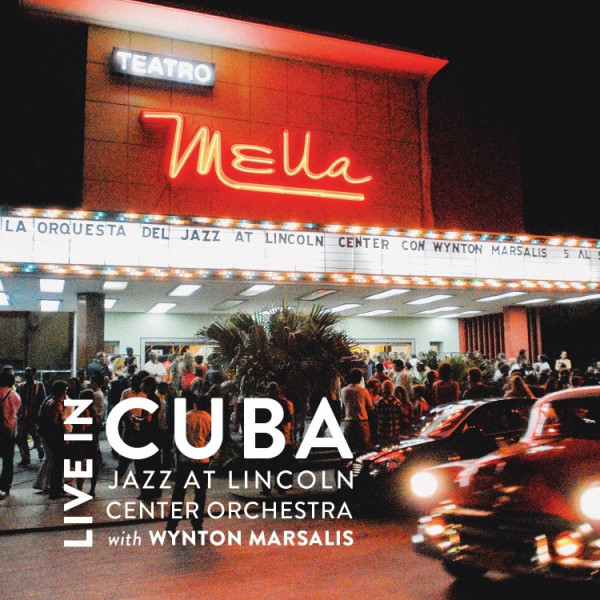
Album Info
| Ensemble | JLCO with Wynton Marsalis |
|---|---|
| Release Date | August 21st, 2015 |
| Recording Date | October 5-6-7, 2010 |
| Record Label | Blue Engine Records |
| Catalogue Number | BE0001 |
| Formats | CD, Digital Download, LP |
| Genre | Jazz at Lincoln Center Recordings |
| Digital Booklet | Download (pdf, 1 MB) |
Track Listing
| Track | Length | Preview |
|---|---|---|
| CD 1 | ||
| 2/3’s Adventure | 8:25 | Play |
| Baa Baa Black Sheep | 11:40 | Play |
| Iñaki’s Decision – from: Vitoria Suite | 11:50 | Play |
| Sunset and the Mockingbird – from Queen’s Suite | 5:32 | Play |
| Como Fue – feat. Bobby Carcassés | 6:57 | Play |
| Dali – from: Portrait in Seven Shades | 7:09 | Play |
| Light Blue | 10:53 | Play |
| Braggin’ in Brass | 7:02 | Play |
| CD 2 | ||
| Limbo Jazz | 6:38 | Play |
| Doin’ (Y) Our Thing – from: From the Plantation to the Penitentiary | 14:35 | Play |
| I Left My Baby – feat. Chris Creenshaw | 7:52 | Play |
| Bearden (The Block) | 6:17 | Play |
| Symphony in Riffs | 8:27 | Play |
| Spring Yaoundé – from: Citi Movement | 5:36 | Play |
| Things To Come | 9:04 | Play |
| The Sanctified Blues – from: Congo Square | 9:34 | Play |
Liner Notes
According to Jelly Roll Morton, jazz music has always had a “Spanish tinge.” A little bit of marching band this, habanera rhythm that – more times than not, the musical influences came from the confluence of identities that fell on the shady side of the razor-thin New Orleans color line.
In 1940, New York resident and trumpeter Mario Bauzá recruited his brother-in-law, Frank “Machito” Grillo, a recently-immigrated singer from Cuba, to create a band capable of playing a new form of music. This infectious sound featured Afro-Cuban rhythms on the bottom and jazz on the top and fused his American musical experiences with the Cab Calloway and Chick Webb orchestras with the Cuban songs and traditions of his youth. They created the first Afro-Cuban band – “Machito and his Afro-Cubans.” This explosive ensemble played all of the trendy nightclubs in midtown Manhattan, eventually earning a residency at “La Conga” on 52nd Street and Broadway.
The quality of this band attracted an eager and enthusiastic public and sparked a surge of creative excitement among many of the greatest jazz musicians of the time. Charlie Parker, Kenny Dorham, and Stan Kenton, to name a few, would be influenced to record Latin albums. Dizzy Gillespie, a fellow trumpeter and section mate of Bauzá’s in Cab Calloway’s Orchestra, as well as a pioneering innovator of the new style called bebop, loved the Afro-Cuban sound. He wanted to integrate it into bebop. Aware of Dizzy’s interest, Bauzá introduced him to the genius Cuban conguero, Chano Pozo.
Dizzy hired Pozo and together, they would create innovative Afro-Cuban jazz recordings featuring masterpieces like “Cubana Be, Cubana Bop” and “Manteca.” The partnership was fruitful but short lived, as Pozo was murdered only one year later. Jazz, however, was forever transformed and Gillespie would champion this fusion for the rest of his storied career.
In 1961, asJohn D. Rockefeller commenced construction on Lincoln Center for the Performing Arts, the Cuban borders were closed to America, ending the formal free flow of arts, communication, and industry between the two countries.
From the 60s through to the 80s, Latin music in New York evolved with new sounds coming primarily from Puerto Rico and the Dominican Republic and their respective communities in New York. The old midtown nightclubs gave way to discos or changed formats, and America’s fascination with the island just 90 miles off the coast of Florida waned.
In 1987, Lincoln Center for the Performing Arts held its first jazz concerts, and in August of 1989, the master Dizzy Gillespie graced the stage. He told the young Artistic Director, Wynton Marsalis, about the importance of maintaining an orchestra by wryly quipping that “to lose one’s orchestral heritage should not be considered an achievement.” Gillespie went on to add that “Bebop was about integration,” encouraging Marsalis to embrace all of the foundations of jazz.
In 1996, Jazz at Lincoln Center became a constituent of Lincoln Center. From birth, the organization has presented and produced all forms and formats of jazz as modern, vibrant, and relevant – from the blues to bebop, be it small group or large ensemble. Today, the beating heart of Frederick P. Rose Hall (affectionately known as the House of Swing) is Dizzy’s Club Coca-Cola, which is dedicated to the legacy of the trumpeter, singer, dancer, teacher, and raconteur who reintroduced mainstream jazz to the delights of that “Spanish tinge.”
Jazz at Lincoln Center has presented the music of Cuban legends such as Chico O’Farrill, Frank Emilio, Chucho Valdés, Paquito D’Rivera, Pedrito Martinez, and Celia Cruz, as well as Afro-Latin legends Tito Puente, Ray Santos, Ray Barretto, and Jerry Gonzales. This album is a culmination of Jazz at Lincoln Center’s efforts to encourage the sharing of a musical heritage that has defined, enlivened, and elevated life in the United States and Cuba.
Following President Obama’s easing of travel restrictions between the U.S. and Cuba, the Cuban Institute of Music invited the Jazz at Lincoln Center Orchestra with Wynton Marsalis to come to Havana. The world had changed dramatically in the 60-plus years since Pozo and Dizzy first came together on stage and in the almost 40 years since the embargo, but this music, in its variety and naturalness, and the overwhelmingly enthusiastic audience response to it, speaks much more clearly to a deeper fundamental heritage that remains very much alive.
On October 5, 2010, the Orchestra embarked on a weeklong residency at the Mella Theater in Havana. Music Director Carlos Henriquez had meticulously programmed four concerts of material to demonstrate the range and capability of this extraordinary band. The musicians conducted master classes, went to jam sessions and gave impromptu lessons—all while being filmed by CBS’s “60 Minutes” and a documentary camera crew.
On their first full day in the city, members of the band went to the Guillermo Tomás Bouffartigue Music Conservatory where they were received with unprecedented warmth and affection. They conducted master classes and were treated to a stellar performance by the students. The next night they played their first concert in the Mella Theater, performing (as is their custom) everything from new compositions and arrangements to the classics. They played everything from Duke Ellington’s “Braggin’ in Brass” to Sherman Irby’s re-arrangement of the nursery rhyme “Baa Baa Black Sheep” to Carlos Henriquez’s new composition, “2/3’s Adventure.” The crowd clapped, cried and laughed, clearly recognizing a sound that resonated deeply, although it had not been heard live for decades. The Orchestra was moved and inspired.
The next night, the Orchestra was back in the Mella Theater for the second concert alongside Chucho’s ensemble, The Afro-Cuban Messengers, playing music of the Cuban diaspora. Arturo “Chico” O’Farrill’s singular masterpiece, “The Afro Cuban Jazz Suite,” featured the Orchestra with Chucho’s rhythm section of Yaroldy Abreu Robles and Dreiser Durruthy Bambolé on percussion, Lázaro Rivero Alarcón on bass, and drummer Juan Carlos Rojas Castro on drums. New arrangements of classics like “Como Fue” were performed along with three original compositions of Chucho’s, arranged especially for a combination of both ensembles. Everyone was showing out and Chucho played the keys right off of the piano. The show was so inspiring that some of the musicians were invited back to the home of legendary Afro-Cuban jazz flautist Orlando “Maraca” Valle for a post concert meal. After the late dinner, they went out into the night armed with instruments, hungry for other jam sessions.
By the night of the final concert, the band had played all over Havana, sowing the seeds of a musical future between Cuba and the United States. The last show was for kids. The packed house was peppered with students from all over the island. They heard Afro-Cuban, jazz and everything in between—a roster of the most promising students performed with the Orchestra in a sweep of jazz compositions that included Lee Morgan’s “Ceora”, Dizzy Gillespie’s “A Night in Tunisia” and Ray Santos’ “Azulito.”
This recording is a compilation of songs chosen from each of these shows. The orchestra was obviously inspired by the experience of reconnecting with their extended family from the deep, deep south. Listen as they try to match the joy and energy of these special audiences. “We had no idea. The hall was vibrating with the intense energy of discovery,” Marsalis said. “We were finding each other, and this opportunity has forever changed our lives.” Orchestra members were all beside themselves talking about the quality of student musicians and the warmth and hospitality of the Cuban people. Please join us on this journey from Cuba to New York, through New Orleans and back again.
All aboard, all aboard.
Credits
CD 1
1. 2/3’s Adventure (8:24)
Carlos Henriquez/Big Papi (ASCAP)
Soloists: Dan Nimmer – piano, Marcus Printup – trumpet, Carlos Henriquez – bass
I wrote “2/3’s Adventure” to commemorate our trip over to Cuba. The song itself has a traveling phase that starts in a generic mambo pattern and goes directly into a swing, then into a guajira. I remember when we debuted it in Cuba. The people started laughing when the rhythm went from swing to a guajira because they didn’t think we knew what a guajira was.
– Carlos Henriquez
2. Baa Baa Black Sheep (11:39)
Traditional. Arranged by Sherman Irby/Sherman Irby Publishing (BMI)
Soloists: Kenny Rampton – trumpet, Chris Crenshaw – trombone, Walter Blanding – tenor saxophone, Sherman Irby – alto saxophone
I wrote the melody the way I learned it, not how the melody was originally composed. When I was in elementary school we used to shout out “BAA, BAA, BLACK SHEEP, HAVE-YOU-ANY-WOOL.” It was important that the song stay short like a nursery rhyme, but darker. I started the song off with an ostinato bass line that sounds like someone’s creeping up on you, and then I made sure to infuse it with the blues so it would get that depth of feeling.
– Sherman Irby
3. Iñaki’s Decision from Vitoria Suite (11:50)
Wynton Marsalis/Skayne’s Music (ASCAP)
Soloists: Wynton Marsalis – trumpet, Ryan Kisor – trumpet, Carlos Henriquez – bass, Dan Nimmer – piano, Ted Nash – flute
It was written for the city of Vitoria and more specifically the founder of the Vitoria Jazz Festival, Inaki. The chord changes are kind of like Monk and the bass plays a big four like New Orleans music. This song encompasses a lot of different forms of music because Inaki’s decision is whether he will continue to sacrifice all that he has for the festival.
– Wynton Marsalis
4. Sunset and The Mockingbird from Queen’s Suite (5:30)
Duke Ellington, Billy Strayhorn/Tempo Music Inc., c/o Music Sales Corp (ASCAP)
Soloists: Joe Temperley – baritone saxophone, Victor Goines – clarinet, Dan Nimmer – piano
5. Como Fue featuring Bobby Carcassés (6:55)
Ernesto Duarte/APRS c/0 Peer Music (BMI) Arranged by Ali Jackson
Soloists: Bobby Carcassés – vocals
We were all doing arrangements for this Cuba project and I initially had a different treatment of the arrangement. At first it was just in swing but I added a cha-cha element in there and concluded it in a ballad. I remember staying up nights rewriting it because it was my first Afro-Latin arrangement for the Jazz at Lincoln Center Orchestra.
– Ali Jackson
6. Dali from Portrait in Seven Shades (7:08
Ted Nash/TNASH Music (SESAC)
Soloists: Ted Nash – alto saxophone, Marcus Printup – trumpet
When I first moved to New York, I spent a lot of time in museums and galleries and it was so inspiring for me. When Wynton asked me to write something for the band in late 2006, I wanted to channel that same energy. At that time, we had a partnership with the Museum of Modern Art, so I would go there on off-hours and play my sax next to some of the paintings. I based this song on Dali’s most famous painting “Persistence of Memory.” I set the time signature in 13/8 because of the melting clocks. The guys in the band call it the “surreal time signature.” Beyond the obvious associations, I tried to create a certain discomfort; like a dream, like the world is a loose end.
– Ted Nash
7. Light Blue (10:52)
Thelonious Monk/Thelonious Music Corp. (BMI) Arranged by Vincent Gardner
Soloists: Dan Nimmer – piano, Walter Blanding – tenor saxophone
Monk put two or three personalities in this song. It’s based on a blues, but it’s not a blues, it’s in double-time and half-time at the same time and it’s very simple. The arrangement has deconstructed elements of the melody in it. Carlos is playing the melody line as the bass line. I tried to stay out of the way of Monk’s intention so I used all of the elements he set up.
– Vincent Gardner
8. Braggin’ in Brass (7:03)
Duke Ellington, Irving Mills, Henry Nemo/EMI Mills Music, Inc., c/o EMI Music Publishing (ASCAP)
Soloists: Wynton Marsalis – trumpet, Marcus Printup – trumpet, Elliot Mason – trombone
CD 2
1. Limbo Jazz (6:37)
Duke Ellington/Sony ATV Harmony (ASCAP) Arranged by Victor Goines
Soloists: Ryan Kisor – trumpet, Joe Temperley – baritone saxophone
Limbo Jazz is actually based on the chord changes of “Happy Birthday” – it’s really simple. The one thing I really changed was that I created a bridge that goes to the relative minor of the song. I used two trumpets and a trombone, a pixie mute and a plunger – something that Duke used many times – to create a pep section. Whenever you have an opportunity to get to the fundamentals of a piece, you can get to what makes the “Spanish tinge” what it is in jazz music.
– Victor Goines
2. Doin’ (Y)our Thing (14:33)
Wynton Marsalis/Skayne’s Music (ASCAP)
Soloists: Wynton Marsalis – trumpet, Carlos Henriquez – bass, Walter Blanding – soprano saxophone
This song comes from Plantation to the Penitentiary. We play in half steps a lot because the theme is supposed to be playful. I would always tell younger people when they are going to do what they want to do anyway and they don’t really want to listen, “Do your thing, but sometimes you can do our thing.”
– Wynton Marsalis
3. I Left My Baby featuring Chris Crenshaw (7:51)
Count Basie, Andy Gibson & James Rushing/WB Music Corp., c/o Warner Chappell Music Inc. (ASCAP)
Soloists: Chris Crenshaw – vocals, Vincent Gardner – trombone
4. Bearden (The Block) (6:15)
Chris Crenshaw (BMI)
Soloists: Dan Nimmer – piano, Victor Goines – tenor saxophone
I took the sounds of the South and tried to integrate them with Northern sounds, particularly because Bearden was born in North Carolina but became known in Harlem during the Renaissance. I tried to combine all of the ideas of his paintings and it ended up turning into a mini suite. I was thinking about Bearden’s collages “Three Guitarists,” “The Block”, “The Block II,” “Reclining Nude”, “Conjuring Woman” and “The Piano Lesson” when I composed this piece. The whole thing moves from a Southern church sound into different tonal centers that are more urban.
– Chris Crenshaw
5. Symphony in Riffs (8:25)
Benny Carter & Irving Mills/Bee Cee Music Company c/o Sobel Global Music (ASCAP) EMI Mills Inc., c/o EMI Music Publishing (ASCAP) Arranged by Benny Carter
Soloists: Marcus Printup – trumpet, Victor Goines – tenor saxophone, Chris Crenshaw – trombone, Carlos Henriquez – bass
6. Spring Yaoundé from Citi Movement (5:34)
Wynton Marsalis/Skayne’s Music (ASCAP)
Soloists: Wynton Marsalis – trumpet
This song was written for a Garth Fagan piece entitled “Griot New York” and it’s about a romantic encounter between a man and a woman. I wrote one piece of it before I saw the choreography and one piece after. It has an unusual form. Most of it changes between 4/4 and 3/4. It was one of the few slow charts we brought to Cuba and when we played it the whole auditorium was very still.
– Wynton Marsalis
7. Things To Come (9:03)
Dizzy Gillespie & Gil Fuller/Music Sales Corporation (ASCAP)
Soloists: Wynton Marsalis – trumpet, Ali Jackson – drums, Vincent Gardner – trombone, Walter Blanding – tenor saxophone
8. The Sanctified Blues from Congo Square (9:35)
Wynton Marsalis/Skayne’s Music (ASCAP)
Soloists: Wynton Marsalis – trumpet
I wrote this tune for “Congo Square” and it uses classic trumpet phrases from New Orleans Second Line parades. On that album it balanced Odadaa’s “Kolomashi” which means colonials go home. Our “Sanctified Blues” means everybody be a part of this. It’s the balance between being a majority and a minority.
– Wynton Marsalis
Executive Producer: WYNTON MARSALIS
Recorded live on October 5-6-7, 2010 at Teatro Mella, Havana, CUBA.
Engineered by Mauricio Blanco and David Robinson
Mixed by Jeff Jones “The Jedi Master”
Mastered by Mark Wilder at Battery Studios, NYC 2015
Art Direction and Design by Frank Harkins
Photography by Frank Stewart and Ayano Hisa
Liner Notes by Simeon Marsalis
Project Manager: Valerie Florville
Music Supervisor: Kay Wolff
Concert and Touring Director: Eric Wright
JLCO Cuba Tour Musical Director: Carlos Henriquez
Special Guests:
Bobby Carcassés – vocals on “Como Fue”
Pancho Terry – percussion on “Como Fue”
Yaroldy Abreu Robles & Dreiser Durruthy Bambolé – percussion on “2/3’s Adventure” and “Como Fue”
Personnel
- Carlos Henriquez – bass
- Ali Jackson – drums, tambourine
- Dan Nimmer – piano
- Ryan Kisor – trumpet
- Kenny Rampton – trumpet
- Marcus Printup – trumpet
- Elliot Mason – trombone
- Vincent Gardner – trombone
- Chris Crenshaw – trombone
- Victor Goines – tenor sax, soprano sax, clarinet, bass clarinet
- Ted Nash – alto sax, soprano sax, clarinet, flute, piccolo
- Sherman Irby – alto sax, soprano sax, clarinet, flute
- Walter Blanding – tenor sax, soprano sax, clarinet
- Joe Temperley – baritone sax, bass clarinet
- Bobby Carcassés – vocals
- Pancho Terry – percussion
- Yaroldy Abreu Robles – percussion
- Dreiser Durruthy Bombalé – percussion
Also of Interest
-
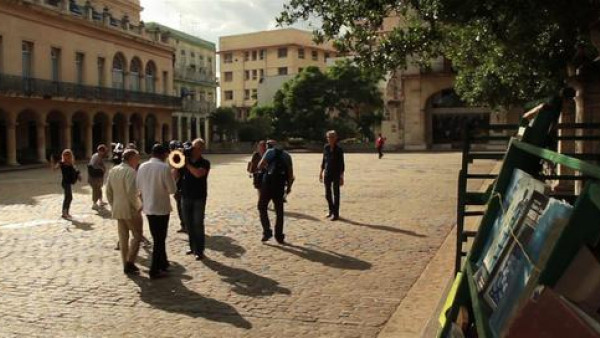 Videos
Videos
Behind the scenes in Havana, Cuba (part II) - Jazz at Lincoln Center Orchestra with Wynton Marsalis
-
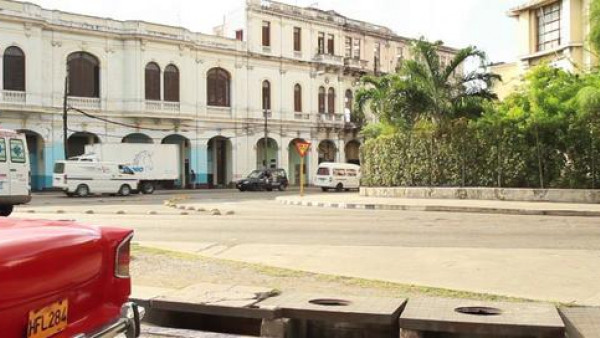 Videos
Videos
Behind the scenes in Havana, Cuba (part I) - Jazz at Lincoln Center Orchestra with Wynton Marsalis
-
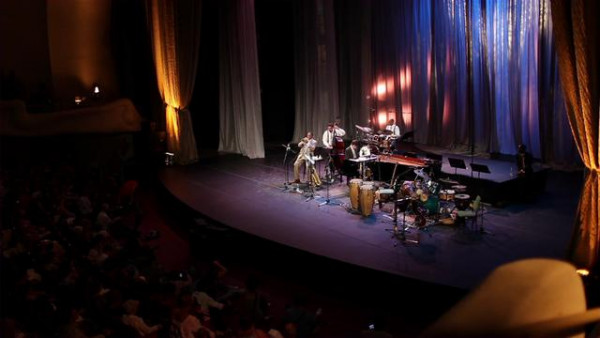 Videos
Videos
Spring Yaoundé - Wynton Marsalis Quintet in Havana, Cuba
-
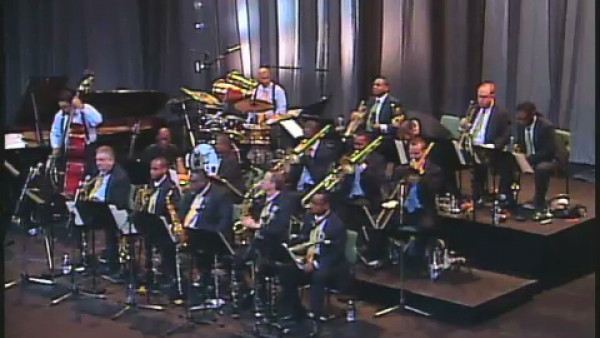 Videos
Videos
2/3’s Adventure - JLCO with Wynton Marsalis live in Havana, Cuba
-
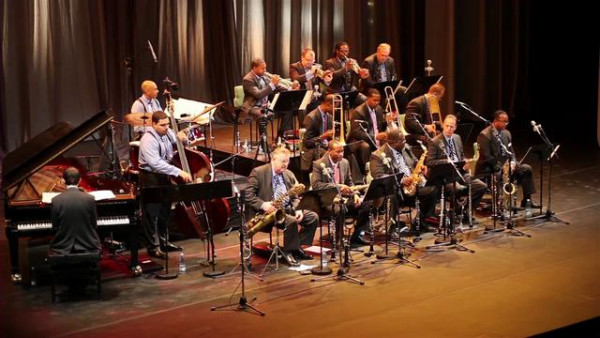 Videos
Videos
Braggin’ In Brass - JLCO with Wynton Marsalis live in Havana, Cuba
-
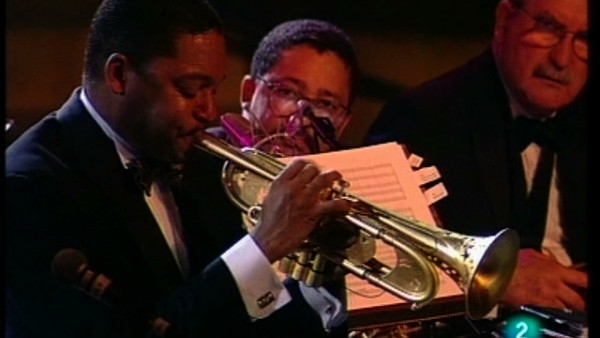 Videos
Videos
Things To Come - JLCO with Wynton Marsalis at Vitoria Jazz Festival 1995
-
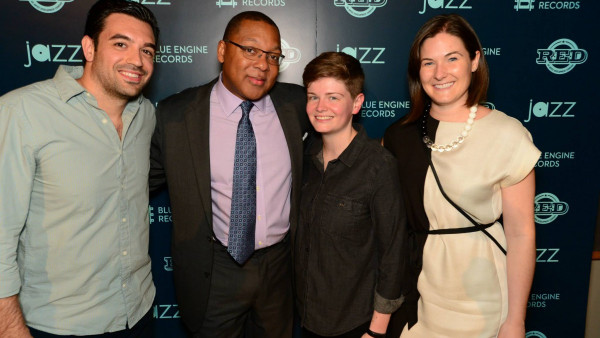 Photo Galleries
Photo Galleries
Blue Engine Records Launch Party
-
 News
News
Blue Engine Records Announces 180gram Vinyl Release of Live in Cuba
